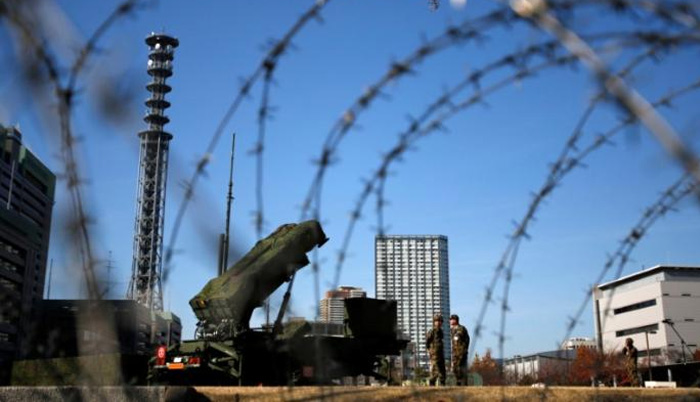![]() Home > Asia
Home > Asia
North Korean Missile Advances Expose Japan in Two-Decade Arms Race: Sources

Members of the Japan Self-Defence Forces stand guard near Patriot Advanced Capability-3 (PAC-3) land-to-air missiles, deployed at the Defense Ministry in Tokyo, Japan, December 7, 2012. | PHOTO: REUTERS/Issei Kato/File Photo
![]() October 4th, 2016 | 08:11 AM |
October 4th, 2016 | 08:11 AM | ![]() 1467 views
1467 views
TOKYO
Successful rocket tests have propelled North Korea ahead in a two-decade long arms race with Japan, leaving Tokyo unsure it could fend off a missile strike by the Pyongyang regime without U.S. help, military sources told Reuters.
Under young leader Kim Jong Un, North Korea has test fired 21 ballistic missiles since the start of the year, an unprecedented burst of activity that has rattled its neighbors and the international community.
"Their progress has been faster than anticipated," a senior Japanese military commander said. "There is a limit to what our current ballistic missile defense system can achieve," he added, asking not to be identified because he isn't authorized to speak to the media.
Planned upgrades to Japan's ballistic missile defense (BMD) are not due to begin until April at the earliest, while the deployment of new systems designed to destroy incoming warheads could take years to complete.
Constrained by production schedules and tight budgets that limit its ability to accelerate those plans, Japan may instead have to lean more heavily on its U.S. ally to guard against attacks, the sources said.
"Our only option for now may be to rely on the U.S. to stop them," said another source at Japan Self Defence Forces (SDF).
MUSUDAN THREAT
Tokyo and Pyongyang have been locked in an arms race since 1998 when North Korea fired a missile over Japan.
In June, a medium range Musudan rocket reached an altitude of 1,000 km (620 miles) on a lofted trajectory, marking a breakthrough that could allow Pyongyang lob warheads over the range of Japanese BMD Aegis destroyers patrolling the Sea of Japan.
That would leave older PAC-3 Patriot missile batteries protecting major cities including Tokyo as a last line of defense. A $1 billion program to improve their range and accuracy will begin after March, but the first will not be ready until the 2020 Tokyo Olympics, sources previously told Reuters.
Warheads from missiles such as Pyongyang's Rodong, with an estimated range of 1,300 km (800 miles), travel at speeds of up to 3 km (1.9 miles) a second. But rockets like the Musudan, which can fly as far as 3,000 km (1,860 miles), plunge from space at speeds reaching 21 km (13 miles) per second, potentially too fast for existing Patriot batteries.
Japan's Ministry of Defense also plans to improve the performance of SM-3 missiles on its small Aegis fleet. The SM-3 missiles are designed to hit warheads at the edge of space, but the sources who spoke to Reuters were unsure they could tackle the Musudan.
A more powerful version of the SM-3 jointly developed by Japan and the United States, dubbed the Block IIA, is nearing completion, with Japan planning to buy the first of those next year. It has not, however, said how many it will acquire, or when they will be deployed.
Longer term, Japan is evaluating whether to buy Lockheed Martin Corp's Terminal High Altitude Air Defence (THAAD) system, to add a middle layer to BMD, or build Aegis batteries on shore to bolster its defenses.
Any roll out of those, however, would take several years because of time needed to study the technology, secure funding and build and integrate the systems, the sources said.
U.S. HELP
As Japan struggles to bolster its defenses, the U.S. is stepping up help to neighboring South Korea, promising last week to speed up deployment THAAD batteries there.
"We still think they need time, but whatever the purpose is, the North is doing things at a rate that is beyond our imagination," South Korean Defence Minister Han Min-koo said in parliament in late August.Pentagon spokesman Commander Gary Ross said the United States had recently reaffirmed its "unwavering and ironclad" commitment to defend both South Korea and Japan, "guaranteed by the full spectrum of U.S. military capabilities, including conventional, nuclear, and missile defense capabilities".
"We continue to support (South Korean) and Japanese efforts to strengthen their respective defense capabilities against the North Korean nuclear and missile threat," Ross said in an emailed response.
For now, Japan is making do with a diminished force. It has four Aegis destroyers each equipped with eight SM-3 missiles. Two of those, however, are laid up for maintenance leaving only two available to watch for North Korean missiles, a third SDF source told Reuters.
The heightened threat "comes just as we face a pinch with our Aegis fleet," he said. "Cooperation with the U.S. Aegis ships deployed in Japan is going to be crucial."
By March 2019 Japan plans eight BMD Aegis ships, but training and maintenance means that only two ships will likely be out on regular patrols at any one time.
U.S. reinforcements that could help cover more sky are, however, sailing into the region. The U.S. Navy, as part of a plan to bolster its presence formulated before North Korea's latest missiles tests, has increased its BMD Aegis ships patrolling the region to ten from seven in the past two years.
Whether that will prove sufficient to protect against further North Korean advances is yet to be seen.
"North Korean ballistic missile technology is progressing step by step and every time we raise our capability they improve theirs," said a fourth SDF source.
(Additional reporting by Jack Kim in SEOUL and Idrees Ali in WASHINGTON.; Editing by Lincoln Feast)
Source:
courtesy of REUTERS
by Nobuhiro Kubo and Tim Kelly
If you have any stories or news that you would like to share with the global online community, please feel free to share it with us by contacting us directly at [email protected]